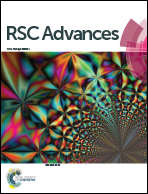Reverse poly(butylene oxide)–poly(ethylene oxide)–poly(butylene oxide) block copolymers with lengthy hydrophilic blocks as efficient single and dual drug-loaded nanocarriers with synergistic toxic effects on cancer cells
Abstract
Combination therapy appears as a very interesting alternative for solving some of the problems associated with single-drug therapies such as drug resistance and improvement of patients' survival. However, it also possesses a series of potential drawbacks, mainly associated with the complicated administration of several antineoplastic drugs, which use different excipients owing to compatibility and stability issues. Hence, the combination of two or more drugs in one polymeric micelle with sufficient loading capacity could solve this constraints as well as provide a suitable control of the release rate and protection for cargos. In this study, four different reverse poly(butylene oxide)–poly(ethylene oxide)–poly(butylene oxide) block copolymers, BOnEOmBOn, with BO blocks ranging from 8 to 21 units and EO units from 90 to 411 were tested as potential single and dual nanocarriers of two antineoplastic drugs, namely, docetaxel and doxorubicin currently used in combination for the treatment of advanced/metastatic breast cancer. Polymeric micelles formed by these copolymers were shown to solubilise important amounts of these drugs, either alone or combined, in a single micelle with a good stability under serum-mimicking conditions. These polymeric nanocarriers were able to release drugs in a sustained manner; the release rate became slower as the hydrophobicity of copolymer chain increased. Drugs loaded in the polymeric micelles accumulated more slowly inside the cells than free DOXO due to their sustained release. Copolymers were found to be biocompatible over most of the concentration range tested. The in vitro cell cytotoxicity was found to be larger for dual DCX/DOXO-loaded micelles than for single-loaded ones, and free administered drugs in both cervical HeLa and breast MDA-MB-231 cancer cell lines were tested by exerting a synergistic effect. Therefore, poly(butylene oxide)–poly(ethylene oxide) block copolymers offer important features as efficient nanocarriers for dual combination therapy, which on combining with the ability of some of the present copolymer varieties inhibit efflux pump mechanisms and allow the development of interesting nanoformulations with unparalleled therapeutic efficacies in cancer treatment.


 Please wait while we load your content...
Please wait while we load your content...